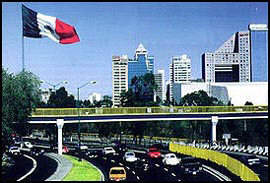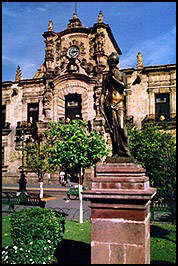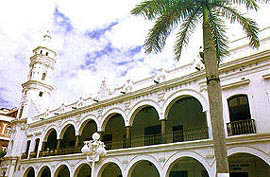 THE DIFFERENT REGIONS THE DIFFERENT REGIONS |
 MEXICO CITY MEXICO CITY |

Mexico City is a place to love and loathe. Spread across more than 2000 sq km of a single highland valley, it encapsulates the best and worst of Mexico the country. The result is a seething, cosmopolitan city that is by turns exhilarating and overpowering. One moment Mexico city is music, glamour and excitement; the next it's drabness, poverty, overcrowding and foul smells. This is a city of colonial palaces, world-renowned cultural treasures and sprawling slums; of ear-splitting traffic and quiet, peaceful plazas; of huge wealth and miserable poverty; of green parks and brown air.
Despite its problems, Mexico City is a magnet for Mexicans and visitors alike, because with nearly a quarter of the country's population, it far outstrips the rest of the country in economic, cultural and political importance. The city is known as either " la ciudad de Mexico " or " el DF ". The DF is the Distrito Federal (Federal District), in which half the city, including all its central areas, lies. The outlying parts of Mexico City are in the state of Mexico, which surrounds the Distrito Federal on three sides.
 MEXICO CITY AND ITS SURROUNDINGS MEXICO CITY AND ITS SURROUNDINGS |
Geographically, the whole area is elevated. South of Mexico City the Cordillera Neovolcanica, with Mexico's highest volcanoes, runs from Pico de Orizaba in the east to Nevado de Toluca in the west (and continues a far west as Colima). North of this range is the Altipano Central (Central Plateau). The altitude makes for a very pleasant climate, cooler and less humid than the lowlands, with rain falling in brief summer downpours. It also makes for a variety of landscapes, from dramatic gorges to fertile plains, fragrant pine forests and snow-capped peaks. Geologically, it remains an active area, with some still-smoking volcanoes and natural hot springs.
Historically the area was home to a succession of important indigenous civilizations (notably Teotihuacan, Toltec and Aztec), and a crossroads of trade and cultural exchange. By the late 15th century, all but one of the small states of central Mexico were under the domination of the Aztec empire. Remnants of pre-Hispanic history can be seen at many archaeological sites, and in museums rich with artefacts ; the Museo Amparo in Puebla gives an excellent overview of the area's history and culture.
After the conquest, the Spanish transformed central Mexico, establishing ceramic industries at Puebla, mines at Taxco and Pachuca, and haciendas producing wheat, sugar and cattle. Most towns still have a central plaza surrounded by Spanish colonial buildings. The Catholic church used the area as a base for its missionary activities in Mexico, and left a series of fortified monasteries and imposing churches.
Despite the rich historical heritage, this is a modern part of Mexico, with large industrial plants and up- and -down transport and urban infrastructure. On weekends many places near Mexico City typically attract crowds of visitors from the capital.
 BAJA CALIFORNIA BAJA CALIFORNIA |
Baja California's native peoples left memorable murals in caves and on canyon walls, but permanent European settlement failed to reach the world's longest peninsula until the Jesuit missions of the 17th and 18th centuries, which collapsed as Indians fell prey to European diseases.
Mainland ranchers, miners and fishermen settled when foreigners built port facilities and acquired huge land grants in the 19th century. It attracts more than 50 million visitors annually for duty-free shopping, sumptuous seafood and activities such as horseback riding, diving, snorkelling, windsurfing, clamming, fishing, sailing, kayaking, cycling, surfing, hiking and whale-watching.
 NORTHWEST MEXICO NORTHWEST MEXICO |
A lot of travellers pass through Sonora, a large state known for its beef, agriculture (especially wheat and cotton) and the great Desierto Sonorense (Sonora Desert) which covers much of the state. Highway 15, Mexico's principal Pacific coast highway, begins at the border town of Nogales, Sonora, opposite Nogales, Arizona, about 1 ½ hours' drive south of Tucson. This is one of the most convenient border crossings between western Mexico and the USA. From Nogales, highway 15/15D heads south through the Desierto Sonorense for about four hours' drive to Hermosillo and then cuts over to the coast at Guaymas, about 1 ½ hours south of Hermosillo. From Guaymas the highway parallels the beautiful Pacific coast for about 1000 km, finally turning inland at Tepic and heading on to Guadalajara and Mexico City.
Not to be missed, the Barranca del Cobre railway (the Chihuahua al Pacífico) between Los Mochis and Chihuahua traverses Copper Canyon, justifiably referred to as the 'Grand Canyon of Mexico'. Los Mochis is near Topolobampo, where the ferry from La Paz in Baja California reaches the mainland.
 CENTRAL NORTH MEXICO CENTRAL NORTH MEXICO |
This area covers a long-used travel route between the USA and central Mexico. The route is along the high plains, parallel to the Sierra Madre Occidental, though flat or undulating country with occasional rocky ranges jutting from the plains. The mostly dry, sparsely populated range land is intermittently from the sierra . The irrigated areas are verdant oases where fruit, cotton and other crops are grown, and where most of the towns have been established.
 NORTHEAST MEXICO NORTHEAST MEXICO |
Northeast Mexico does not have impressive pre-Hispanic ruins, charming colonial towns, or pretty palm-fringed beaches. What it does have is a geography unlike anywhere else in Mexico, and an emerging culture that is unique in the world.
Geographically, the deserts of northeast Mexico are the southern extension of the Great Plains of the USA and Canada, sheer expanse. The Rio Grande, often called the Río Bravo del Norte in Mexico, is vital for irrigation in this arid region, and it has been developed as a resource by joint Mexican-US projects. In fact, it may have been over-developed, and attention is now being paid to environmental quality along the river. The coastal areas have remote beaches, lagoons and wetlands that are home to many types of marine life, and a winter stopover for many migratory birds. Going inland, numerous winding roads climb to the eastern and northern edges of the Sierra Madre Oriental, offering spectacular scenery and a refreshing highland climate.
 CENTRAL PACIFIC COAST CENTRAL PACIFIC COAST |
Stretching from Mazatlán to Acapulco, the Central Pacific Coast contains some of Mexico's principal beach resorts - Mazatlán, Puerto Vallarta, Zihuatanejo-Ixtapa and Acapulco.
Coastal highways make travel easy up and down the coast, with frequent buses and easy driving, while several other highways connect the coast to the mountainous interior of the country. Due to the high volume of tourists, both national and international, air services to this region are also frequent and convenient.
 |
 WESTERN CENTRAL HIGHLANDS WESTERN CENTRAL HIGHLANDS |
West of Mexico City lies an upland area of great geographical and cultural variety encompassing the inland parts of the states of Jalisco, Michoacán and Colima. This region is off the really major tourist routes but has many attractive destinations, among them the country's vibrant, second largest city Guadalajara, capital of Jalisco ; the fine capital of Michoacán, Morelia, and the spectacular El Rosario monarch butterfly sanctuary to its east ; the lovely colonial town of Pátzcuaro in the Michoacán highlands inhabited by Tarascan (Purépecha) Indians ; and the volcano Paricutin, which rose in 1943 from the lush Michoacán country around Uruapan. Beyond these lie hundreds of kilometres of backcountry ripe for exploration.
 NORTHERN CENTRAL HIGHLANDS NORTHERN CENTRAL HIGHLANDS |
Northwest from Mexico City stretches a fairly dry, temperate upland region comprising the southern part of the Altiplano Central. This was where the Spanish found most of the silver and other precious metals that were so central to their colonial ambitions in Mexico - and where they built some of the country's most magnificent cities from the great fortunes that silver brought them. The most spectacular of these are Guanajuato and Zacatecas, which along with Potosí in Bolivia were the major silver-producing centers of the Americas. San Miguel de Allende, Querétaro and San Luis Potosí also have a wealth of colonial architecture. Today most of these cities are still of moderate size and have lively arts and entertainment scenes.
This is a highly rewarding region to visit. The distances are not huge and the landscape between the cities is always impressive, with vistas to mountains near or far. The land becomes steadily more fertile as you move south from Zacatecas and San Luis Potosí to the area around Guanajuato and Querétaro known as the Bajío, which has long been one of Mexico's major agricultural zones.
Before the Spanish reached Mexico, the Northern Central Highlands were inhabited by fierce semi-nomadic tribes known to the Aztecs as the Chichimecs . They resisted Spanish conquest longer than all other Mexican peoples and were only finally pacified in the late 16th century by an offer of food and clothing in return for peace. The wealth subsequently amassed in the region by the Spanish was at the cost of the lives of many of these people, who were used as virtual slave labour in the mines.
Mining is still important in the region and there's industry as well - in León , Querétaro Aguascalientes and elsewhere - but the industry doesn't detract from the region's historical, artistic and scenic attractions.
 CENTRAL GULF COAST CENTRAL GULF COAST |

The route from northeast to southeast Mexico and the country's central mountains. Veracruz - a holiday resort for Mexicans - is the most appealing of the coastal cities, with a festive atmosphere and one of the country's most riotous carnavales. A number of cities lie inland, in the foothills of the Sierra Madre ; Jalapa, the capital of Veracruz state, and Córdoba are the most attractive.
It's an area with a fascinating prehistory but only one major archeological site - El Tajín, near Papantla, which shouldn't be missed as you travel through. Southern Veracruz was the Olmec heartland, but there's little to see there now. The best collections of Olmec artifacts, including several of the mighty 'Olmec heads' of sculpted basalt, are in the Museo de Antropología in Jalapa, and at Parque-Museo La Venta in Villahermosa. The Jalapa museum has by far the best archeological collection from the Gulf Coast as a whole.
 OAXACA STATE OAXACA STATE |
The rugged southern state of Oaxaca reaches to within just 250 km of Mexico City but, divided as it is from central Mexico by barriers of mountains, it remains a world away in atmosphere. It enjoys a slower, sunnier existence and a magical quality that has something to do with the dry, rocky landscape, the remoteness, the bright southern light and the spars population. The high proportion of Indians in Oaxaca's population are the driving force behind the state's fine handicrafts.
Oaxaca city is a major travel destination yet remains beautiful and artistic. Around it, in the Valles Centrales (Central Valleys), are thriving village markets and spectacular ruins of pre-Hispanic Indian towns such as Monte Albán and Yagul. On the beautiful Oaxaca coast, Mexico's newest tourist resort is growing up on the lovely Bahías de Huatulco. Puerto Escondido and the Puerto Ángel area are older beach destinations that will probably always remain small scale and more laid back. The Oaxaca coast was ravaged by Hurricane Pauline in 1997, but the Bahías de Huatulco and Puerto Escondido came through with relatively little damage, and the travellers' scene around Puerto Ángel is likely to revive quickly.
The backcountry of the region is as far from Oaxaca city in culture and travelling time as Oaxaca is from Mexico City. There's enough of it to offer weeks of exploring.
Lying in a region where temperate and tropical climatic zones and several mountain ranges meet, Oaxaca has spectacularly varied landscapes and a biodiversity greater than any other Mexican state. The oak and pine forest, while lower-lying areas and the Pacific-facing slopes of the southern mountains support deciduous tropical forest.
 TABASCO & CHIAPAS TABASCO & CHIAPAS |
Just east of the Isthmus of Tehuantepec - Mexico's narrow 'waist' - lie the states of Tabasco and Chiapas. Their differences define them : Chiapas is rich in potential but poor in reality, whereas Tabasco is an oil-rich boom land. Chiapas is mostly mountainous and volcanic, with forests of oak and pine, while Tabasco is low, well watered and humid, and mostly covered in equatorial rainforest. Chiapas' is Olmec and Totonac.
Separated from the cosmopolitan centers of Mexico City to the northwest and Mérida to the northeast, the Tabascan capital of Tuxtla Gutiérrez generate their own isthmian society. Both with frontage on the mighty Río Usumacinta and borders with Guatemala, the two states share a cross-border history of cultural exchange and conquest.
 THE YUCATÁN PENINSULA THE YUCATÁN PENINSULA |
When you cross the Río Usumacinta into the Yukatán Peninsula, you are crossing into the realm of the Maya. The appearance of the countryside changes, as do the houses and the people in them. Inheritors of a glorious and often violent history, the Maya live today where their ancestors lived a millennium ago. The Maya are proud to be Mexican, but even prouder to be Maya, and it is the Mayab - the lands of the Maya - that they consider their true country.
Though it is flat and hot, the Yucatán Peninsula
has surprising diversity. There are archaeological
sites galore, several handsome colonial cities,
Mexico's most popular seaside resort and quiet coastlines
populated mostly by exotic tropical birds. |

